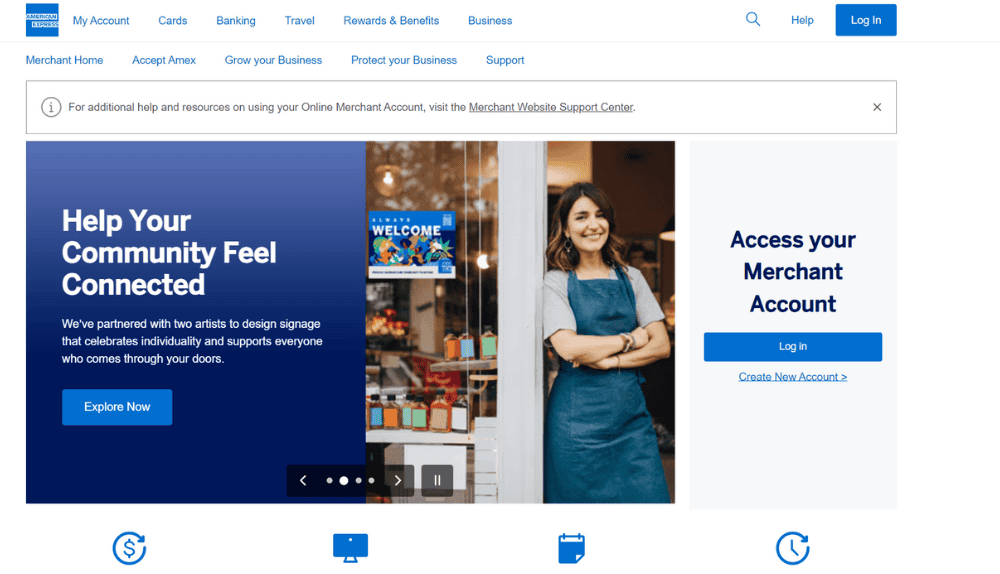
Understanding American Express Merchant Services
- 04th Jun, 2024
- | By max
- | Credit Card Processors
The biggest concern for any merchant is the processing fees they need to pay to accept card payments. Besides transactional fees, other charges may be associated if you hire a payment processor – a payment solution provider that acts as the bridge between the merchant and the bank. So, a payment processor is responsible for transmitting transactional information from the customer’s credit card to the bank accounts of the customer and the merchant.
Sadly, many payment processors charge hidden fees, which merchants often pay for unknown reasons. If paying high payment processing fees is challenging, Amex or American Express Merchant Services is your best solution. Amex has a transparent pricing plan and offers a robust package for merchants across diverse industries.
Now, you need to open an American Express merchant account to accept electronic payments from customers seamlessly. This particular bank account enables businesses to receive and process e-payments. So, a merchant account acts as the middleman between the customer’s and the company’s bank account. A merchant account is the intermediary that holds the funds after accepting the transaction from the customer until the funds are transferred to the merchant’s regular financial institution.
This article will discuss why American Express is the best merchant service solution for your business and how you can become an Amex merchant in simple steps. Furthermore, we will also understand the fees associated with Amex merchant services so you can make informed decisions.
An Overview of American Express Merchant Services
Merchants are often confused about the solutions provided by American Express merchant services. You may have doubts or queries regarding Amex merchant solutions’ settlement procedures, discount rates, and pricing models. Let’s discuss them in detail.
How Do American Express Merchant Services Work? Why is Amex Different?
What’s more impressive about American Express is that it works via a closed-loop network. That means that Amex will open merchant accounts directly for businesses that accept Amex cards and issue credit cards directly to Amex cardholders.
This is where American Express is different from other card brands. For example, Visa and Mastercard connect with various banks to issue credit cards to cardholders. Furthermore, these card brands do not provide merchant account services, such as opening or maintaining merchant accounts for business owners. Merchants should rely on credit card processors to open and manage merchant accounts.
But thanks to American Express for offering merchants all-inclusive solutions for opening and maintaining merchant accounts, enabling them to manage customer payments smoothly daily. Amex is not answerable to or linked to any other financial institution for acquiring or issuing credit cards. Therefore, the merchant and credit card service provider can independently set its discount rates based on market conditions.
What we found impressive about American Express is that it has set a flat rate equal for all payment processors. Furthermore, it does not allow any payment processing system to add a markup charge. Although the rates for processing Amex credit cards were initially higher than processing Visa or Mastercard credit cards, the multinational financial services brand has recently modified its pricing models. We will discuss these newly introduced pricing plans towards the end of the article.
Benefits of Accepting American Express Cards for Your Business
You might be wondering whether it is profitable to accept Amex cards. We know your worries stemmed from the relatively high discount rates and highly delayed fund settlements, which may affect business operations and resources. However, in recent years, American Express has made innumerable upgrades and changes in its pricing plans and transaction settlement speeds.
So, instead of being skeptical about the benefits of accepting American Express transactions, it’s time to consider the new pricing models, such as Amex OptBlue. This newly launched pricing plan has immense potential for keeping your American Express payment processing charges low while settling the funds faster than the traditional Amex merchant solutions.
However, you should know that even with OptBlue, your Amex processing charges will be higher than those for Mastercard and Visa card payments. But it is significantly lower than what merchants used to pay earlier.
So, considering whether to accept Amex cards, consider the two major factors: your business’s cash flow requirements and customer demands. If you would be profitable by accepting American Express credit cards, why not go for it?
For instance, you cannot accept American Express cards if your business is associated with travel and tourism, food/restaurant service, or the entertainment industry. That’s because of higher customer demand, and you will come across multiple Amex cardholders.
Similarly, while catering to a professional client base, you must accept Amex payments based on your client’s demands. Furthermore, many corporate cards today are American Express cards since they provide impressive rewards for every transaction. So, Amex is typically the first preference for more wealthy clients who love traveling with American Express credit cards.
Businesses can enjoy the following benefits by accepting American Express credit cards.
- The discount rates may not be as high as you think, especially after the launch of the Amex OptBlue pricing model.
- You can protect your business against fraudulent activities and other data breach threats, thus safeguarding your clients’ sensitive card information.
- Merchants can get 24/7 support service to promptly address any payment-related issues.
- Small businesses in the US can gain access to about 3X higher spending capacity compared to competitors.
- You can reach Amex card members who make an average annual spending of 3X compared to other non-card members.
American Express is the fourth-largest credit card company globally, and that’s for good reasons. You might lose many clients for not accepting Amex cards. That’s because American Express cardholders find paying using this highly-rewarding card convenient. So, if you are not accepting Amex cards, you indirectly tell your clients that you value paying lower transaction rates more than valuing their convenient mode of payment. Modern-day businesses should focus on providing higher customer values to be more profitable in the long run.
How to Become an American Express Merchant?
If you are willing to accept American Express cards in your business and wish to open an Amex merchant account, here are the two simple steps.
Step 1: Consult a Payment Processor
To open an American Express merchant account, it may not be mandatory to contact Amex directly unless, of course, you are processing transactions of $1 million or more in a year. Otherwise, you can request your credit card processing company to open an American Express merchant account on your behalf, if you have decided to start accepting Amex payments. Make sure to use the OptBlue pricing model while opening your Amex account.
Your payment processor should be able to integrate your Amex merchant account into your current credit card payment gateway, POS device, or other payment processing solutions. It will ensure that all Amex card transactions are received, authorized, and processed through that system. However, if you are yet to get a payment processor for your business, your first step would be to opt for one by finding a reputable payment processing company.
Step 2: Transfer Your Amex Merchant Account
It’s essential to keep in mind that your business cannot have more than one American Express merchant account. So, if your payment processor has already opened an Amex merchant account earlier, you cannot open a second account, even if you have changed your processor. So, if you are already an Amex merchant account holder, continue using it to accept Amex card payments.
Therefore, you must link your new payment processor with your existing Amex merchant account number. It will help the credit card gateway, machine, or other POS equipment to refer to that account number while processing your Amex sales. Contact American Express directly if you have forgotten or lost your existing Amex merchant ID number. That’s because a payment processor won’t be able to recover a lost merchant account number on your behalf.
If you have never opened an Amex merchant account, you can proceed towards opening a new account. Your payment processor will help you with that. After successful registration, it’s time to link your account ID with your payment processor to start accepting Amex payments.
The American Express Pricing Plans You Should Know
The current pricing plans for American Express merchant accounts include Amex ESA and Amex OptBlue. Here’s a detailed overview of fees associated with Amex merchant services.
● Amex ESA
American Express ESA, also known as Amex Direct, is a direct processing program that allows businesses to have a merchant account directly with Amex. It is a dedicated merchant services account, and American Express is responsible for settling transactions. Therefore, all the payment processing procedures, such as fees and fund deposits, are managed exclusively by American Express.
In the Amex ESA pricing model, merchants will automatically receive a bill from American Express at the end of every billing cycle. This billing structure is separate from any other bill merchants may receive for Mastercard or Visa transactions. Amex Direct or Amex ESA follows a flat-rate structure that was implemented before launching the more optimized OptBlue pricing program.
When a merchant has a direct account with Amex, the total Amex transactions they receive and process should be above $1 million. So, if your business is already processing $1 million yearly with Amex, you should have a direct account with this merchant account service provider. However, Amex allows some particular industries to process payments of less than $1 million, and they can still enjoy the benefits of an American Express Direct merchant account.
● Amex OptBlue
Amex OptBlue is the latest pricing plan similar to Mastercard and Visa’s. The OptBlue model was launched in 2015 to replace the previous Amex OnePoint plan (also called the Amex Full Service plan). The American bank holding company rolled out this pricing model, and merchant solution to help payment processors manage merchant accounts efficiently and add an appropriate markup.
The Amex OptBlue pricing plan offers a paradigm shift for merchants to help them reduce their Amex payment acceptance costs. However, many business owners are still unaware that this new model has huge potential for merchants to save a few extra bucks for accepting Amex card payments.
If you are new, try the American Express OptBlue package. It enables business owners to open an Amex merchant account via a credit card processing company instead of getting it directly from American Express.
After replacing the previous Amex OnePoint model, OptBlue can efficiently streamline settlements and authorization and successfully report all American Express transactions. Moreover, unlike OnePoint, OptBlue is designed to help payment processors add a markup charge on top of Amex’s base rates. It allows the system to create different processing rates for Amex based on other processors.
The American Express OptBlue model is similar to the procedures of Mastercard and Visa. Both these companies have a flat base rate, commonly known as interchange rates, to which the processor adds its respective markup fee.
Although Amex’s base rates are not termed “interchange rates,” they work similarly to those of Visa and Mastercard. The base rates remain the same for every processor and are non-negotiable. The total processing fees vary only because of the variation in the markup fees, which differ for every processor.
An Overview of Amex Discount Rates
American Express’s discount rates depend significantly on your merchant category code (MCC). A credit card company uses this MCC number to categorize different purchases based on the merchant type. It is a four-digit number that the credit card company assigns to different businesses. The Merchant Category Code is used for multiple purposes, such as calculating or reporting credit card/cashback rewards. Besides, an MCC number denotes the amount a merchant must pay while accepting debit or credit card payments.
Unlike the interchange fees of Mastercard and Visa, Amex discount rates have fewer eligibility criteria. When a transaction is made using the keyed-in methods, that is, when the card details are entered into the payment processor manually rather than swiping the card, Amex discount rates for restaurants and retail outlets will decrease (meaning the total rate will increase).
Therefore, encourage your customers to swipe in their cards rather than keying in the card details to enjoy good discount rates. However, irrespective of the transaction method, most rates will remain the same. Moreover, Amex does not charge a discount rate or a credit card payment processing fee for every industry type or category. Many Amex processing rates include a percentage-based fee (discount rate), which does not include a transaction fee.
However, to sum up, all credit card processing companies will charge merchants a specific fee for processing American Express card transactions over their network. This means that even if Amex does not charge you a processing fee directly, you will have to pay your credit card processing service provider a transaction fee to receive and process Amex card transactions.
The Settlement Process of American Express
Merchants accepting Amex transactions must know that some American Express payments take longer to settle than Mastercard and Visa transactions. In other words, the funds may take longer to transfer to your linked business account than when Visa and Mastercard payments are reflected in your bank.
Visa and Mastercard transactions are usually settled within 24-48 hours, except in some cases of processor-imposed risks. In short, after the authorizations are approved and sent to the payment processor, the funds will get reflected in the merchant’s checking account within 24-48 hours for Mastercard and Visa card payments.
However, American Express transactions usually settle in the merchant’s account almost twice as fast as Mastercard and Visa transactions. The Amex card funds may take 3-7 business days to transfer from the customer’s account to the merchant’s checking account. The only exception is when the merchant enrolls in the Amex OptBlue pricing model.
The OptBlue pricing plan works by settling all the card transactions of the month and other card transactions, including Visa, Mastercard, and Discover sales. So, it’s time to say goodbye to delayed settlements and receive separate statements for American Express card payments because all transactions are settled in a single deposit. Unlike traditional Amex merchant accounts, it also ensures faster fund transfers and lower transaction rates.
Final Words
We hope the article guided you to decide whether to accept American Express cards for your business. It all depends on customer demands and your industry. Also, consider your cash flows to decide which pricing model will be most suitable for your business.
We suggest you start accepting Amex cards to widen your customer base. You will see positive results in the long term. Plus, it’s important to make your clients feel more valued so they will keep coming back to your store.


